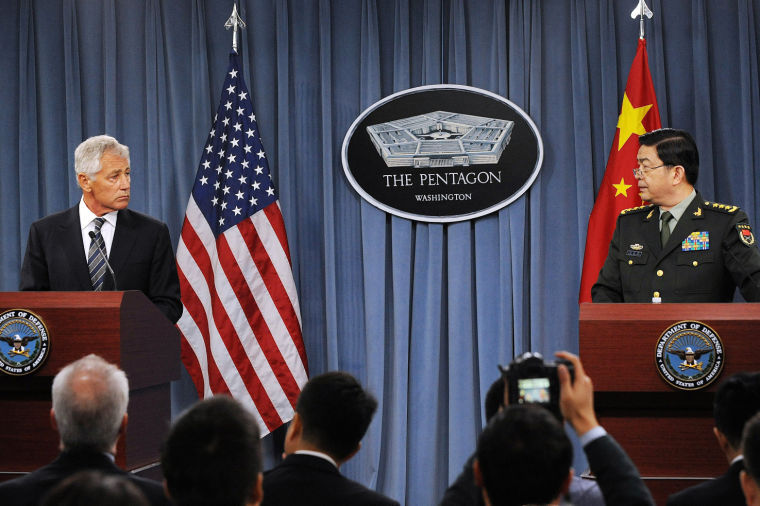Build bonds, not barriers
Defense Secretary Chuck Hagel looks on at a news conference with China’s Minister of National Defense Gen. Chang Wanquan at the Pentagon in Arlington, Va., Aug. 19, 2013.
April 30, 2014
Chuck Hagel made his first trip to China as defense secretary on Tuesday, April 8, bringing kind words of cooperation, flowery praises for a growing economy, and something else — a stark warning.
President Obama and Secretary Hagel have both reaffirmed U.S. commitments to Japanese territorial integrity under NATO’s Article 5 this month in hopes of deterring further Chinese aggression directed toward the Senkaku Islands.
China has been increasingly militaristic and volatile in the last several years, going as far as asserting control over the skies above Senkaku and other waters that overlap with Japanese and South Korean air defense identification zones last November.
In response, intercepts of Chinese aircraft by the Japanese Air Self-Defense Force increased by 36 percent in the 2013 fiscal year (FY), as reported by IHS Jane’s, a defense analysis and threat assessment organization.
With a defense budget nearly six times higher than that of China, there should be no doubt as to the United States’ capabilities in defending its allies in the region.
During the next 10 years, however, that gap is going to start closing.
The Washington Post outlined the effects of the Obama administration’s FY2015 budget projections quite clearly: U.S. spending on defense, without accounting for inflation, will remain stagnant through 2024.
China, on the other hand, is increasing its defense budget by 12 percent this year, and at that rate, will double its expenditures in just six years.
This isn’t an unrealistic scenario, either, as the Chinese have consistently added 10-12 percent to that budget per year for the last three.
What most Americans don’t realize, thanks in no part to the media attention given to the Ukraine crisis, is that China is already nearly doubling the military spending of our old Cold War adversary, Russia – something Obama forgot to mention as he characterized Russia as a “regional power” while reiterating his commitment to an Eastern-facing strategic shift.
If you’re not troubled by their rapidly increasing military budget, perhaps their capability will shake you back into reality. According to ABC News, China unveiled a prototype for a fifth generation fighter in 2011 that is eerily similar to the incredible F-22, no doubt a product of increased espionage efforts.
A Defense Security Services report from that year has shown that 25 percent of collection efforts in FY2010 were aimed at information systems with another 8 percent directed at aeronautic industries. The massive expenditure that the United States has undertaken in order to develop the world’s best weaponry is being almost wholly avoided by our Chinese counterparts.
As a result of these prevailing tech collection efforts, the Pentagon described cyber-security as their No. 1 priority, and according once more to IHS Jane’s has allocated $5.1 billion to cyberspace operations for the 2015 fiscal year, an 8.5 percent increase from 2014.
Finally, the head of U.S. Pacific Command, Admiral Samuel Locklear, professed to the Armed Services Committee on March 25 that China was likely to equip its submarines with long range nuclear missiles by the end of this year, a Great Leap Forward in destructive capabilities.
President Obama was right to conduct an Asian pivot, as the face of geopolitics is changing rapidly.
The choice the U.S. now faces is whether to treat China as we did the Soviet Union with containment policies, or pursue a more peaceful and cooperative approach.
Secretary Hagel stated on his April 8 visit that he believes it is in both nations’ best interest to foster cooperation and closer ties, and frankly, I agree.
More than one-third of the world’s global trade goes through the South China Sea, and trade between China and the U.S. last year was in excess of $500 billion.
The interdependence that has come to characterize the relationship of our two nations is both dangerous and inspiring.
The Chinese contribute more personnel to peacekeeping missions around the globe than any other nation, and they have historically acted in self-defense.
While their troubling intrusions into American infrastructure and posturing toward U.S. allies in the region is likely to continue, any sort of confrontation would be catastrophic for the world at large.
The United States and China should look to the lessons learned from the Cold War as a warning of what is possible, both bad and good.
Our relationship may inspire global peace and cooperation on unprecedented scale—a model for a better tomorrow. As former Defense Secretary Harold Brown said on his trip to China in January of 1980:
“There is no country, no matter how rich or how militarily powerful, no matter how numerous in population, no matter how great its potential in natural and human resources – there is no country so great that it does not need the help of friends.”
– Bryan Allen is a junior political science major from Puyallup. He can be contacted at 335-2290 or by [email protected]. The opinions expressed in this column are not necessarily those of the staff of The Daily Evergreen or those of Student Publications.





















